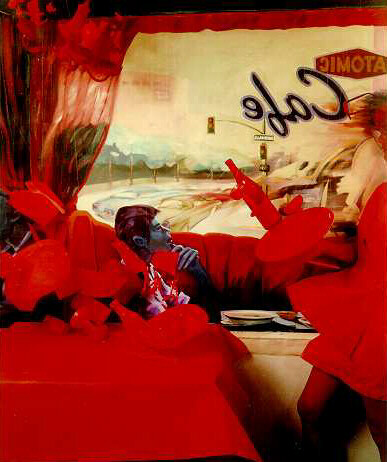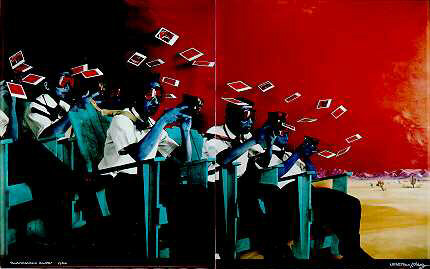ATOMIC POLAROIDS
Patrick Nagatani & Andrée Tracey

We
are inside a typical American eatery, but at an onerous moment, an
interval in time when something is occurring that mind refuses to
grasp ---the flash and blast of an nuclear bomb has just hit the
Atomic Cafe...silverware, dishes, bottles, food, almost everything's
up in the air, levitating in mid-air; but not every thing reacts:
dishes on the table in front of a customer sit still, like him, held
by a spell.
Radioactive winds have transformed the world into a pastel scene of blowing
dust. The
traffic light warns both Caution and Stop, its electronic banner
says Don't.
From childhood we associate red with mishap, damage and pain, with personal blood. It is the liveliest, and deadliest, of color, the fire that purifies mind, burns down old grammars, makes slag of ideologies. Rene Huyghe reminds us that "in prehistoric times the bones of the dead were coated with red; this was thought to promote a continuity of vitality and to promote posthumous rebirth."
Photography, too, is a revenant. We are told by Gunter Kunert that "the ancients conceived of the inhabitants of Hades (as we see) figures in a photograph," who could be recognized but not touched. What better color with which to picture the end of the world than red, especially when we know that Polaroid film favors red? And in what better medium then photography, whose very essence is a venue where mind, stopped by an image, backtracks spontaneously into memoria.
***
The Polaroid
Land process, with its self-developing reagent, was introduced in
1948. It was a new toy for the amateur "shutterbugs," who
had been, since the 1880s, when the Kodak was first marketed, "running
amok
with cameras." However, John A. Kouwenhoven quickly adds to his pejorative
that "there was an amazing amount of significance, historical and otherwise,
in a great many things that were deeded impertinent until snapshots began forcing
people to see
them."
Snapshots are the easiest way for a family to record and collect
its
ontogenesis, in albums that are, as Roland Barthes says, "a kind of primitive
theater
(of) motionless made-up face(s) beneath which are the dead." (The Polaroid
acts as an instant resurrection machine.) The snapshot is also the forerunner
of Pop Art, which is "instantly to the point, extroverted rather than introverted...a
product of America's
long-finned, big-breasted, one-born-every-minute society." (Lucy Lippard).
Polaroids not only exaggerate this paradigm in time, but, with the development
of its 20-by-24-inch
format, in space as well.
Standing 5ft. tall in
a mahogany cabinet, weighting 200 lbs., there are presently only
five of these cameras in the world. Usually accessed by rental, a
few
artists--Patrick Nagatani and Andrée Tracey among them--were (and continue to
be) invited by Polaroid Corporation to the cameras' various locations in order
to exploit the format's aesthetic possibilities. With them came crates filled
with props, painted scenery, life-size photographic mockups, hundreds of miles
of monofilament wire... It was like the arrival of a theatrical road company,
there to perform its "constructed-to-be
photographed art" before the camera's delighted eye.
Nagatani is a photographer with graphic arts training; Tracey is
a painter knowledgeable in photography. Both artists shared equally the project's
sundry responsibilities in a work process that refers back to the temporary
installations of the 1960s, which were also photographically extended. Photo-documentation
of ephemeral art, along with West Coast Pop Art, and the tableaux of Edward
Kienholz which simultaneously
fused "imitation with creation, literalness with outrageous fancy" (Maurice
Tuchman), are among the potent influences on this work.
Painted bones or painted props, it is all performance, with the waitress played by Andrée Tracey. The objects are suspended on wire, clearly seen. Here is the artists' act of compassion, because, as Robert Jay Lifton counsels, "We must imagine something close to nuclear extinction in order to prevent it." Imagine it, mindful to its consequences, working it out culturally as a sign of our potential for both further life and panocide."
***

Alamogordo Blues
is based on a photograph allegedly taken of men observing Operation Greenhouse,
a test of a nuclear device made on the Pacific atoll of Eniwetok, November
1, 1952. There are several interesting asides to this test. One is that
it took place in the area where
Herman Melville wrote that the ship Pequod was sunk by the great white
whale,
Moby Dick. Another is that the protective shed that housed the device "reminded
some of the participants of the Kaaba, the building which houses the sacred stone
of the
Moslems at Mecca." (Robert Jungk) More to the point, Nagatani quips that
the observers were told that keeping their mouths shut would assure them safety
from the
effects of radiation.
In this picture, behind dark rubricated goggles, the participants are all Japanese. Their SX-20 prints of the nuclear mushroom are flying out of their cameras and back over their shoulders as if salt tossed for good luck. The photographer is here too, squeezed in among his cousins. An aunt of his was burned at Hiroshima. But even if he had no personal place in the picture, nothing stops the artist in his mission of creating simulacra. Subjectively, he is like Jean Tinguely's machine that was "built for no purpose but to commit 'suicide' by smashing itself, blowing itself up." (Harold Rosenberg) This "suicide" was recorded on film, the camera being an instrument that creates infinite time. Tinguely's machine is dead. Long live Tinguely's Machine!
Modernism, with its implosive
turn, emerged out of our faith in progressive inventions. Postmodernism,
I suggest, began precisely at 5:29:45 a.m, Mountain War Time, on
July 16, 1945. At that moment, "the firing circuit closed; the
X-unit discharged; the detonators at thirty-two detonation points
simultaneously fired" (Richard Rhodes)---and for the time on
this planet the basic stuff of the universe was consciously split,
an immensely deadly power released, new elements created. If
modernism denotes the ambitious creation of forms, even to the extent
of trying to materialize spirituality, postmodernism fulminates the
promise of duration, along with the myth of Creation itself. The
Bomb was the climax of the Modern World. Now we interpret fragments,
shards, the damage done by a zealous beliefs that Rationality equates
with sanity, that faithfully led to that fateful morning in New Mexico.
"It is the sane ones, the well-adapted ones, who can without qualms and
without nausea aim the missiles and press the buttons that will initiate the
great festival of
destruction that they, the sane ones, have prepared," wrote Thomas
Merton,
in A Devout Meditation in Memory of Adolf Eichmann. "They will
be obeying
sane orders that have come sanely down the chain of command."
After it was done, when the dreadful fireball had eclipsed the rising sun, J. Robert Oppenheimer, a model of the modern educated man--scientist, linguist, administrator--was heard to remark, "My faith in the human mind has been somewhat restored."
***
All the men
in Alamogordo Blues are (painted) blue, the cold blue of
death. "There was a chill which was not the morning
cold," said physicist I.I. Rabi. The wind (blue=blow; O.E. blaw) blowing
into their faces--hair and neckties flying back--so they cannot catch their breath,
blue being a
symptom of asphyxiation, a variation of the "blue baby syndrome," symbolic
of those children born of and into the Nuclear Age. For the photographer the
world is always just beginning, his body of work wet with amniotic fluid, the
chemical soup in which human life, along with the images it creates, begins to
develop.
In these constructions, Nagatani and Tracey never hide the fact
that what
they've created is imaginal. Their pictures are powerful in part because
we are able to see the wires, allowing us to participate in the ritual of their
aesthetic. Accepting
this logic, we can act spontaneously. "The exquisite truth," wrote
Wallace
Stevens, "is to know that it is fiction and that you believe it willingly."
Among the painted and pre-photographed images, however, Nagatani
and Tracey slip in another layer, alive for the moment, doubling the scene
into allegory. Again and again the artists are teaching that images, beliefs,
ideologies, are only styles of
perception. "in the nuclear age," said psychologist Robert Bosnik, "we
may need to create a form of cultural therapy, a way of examining the dreams
and visions that
impel humanity as a whole toward self-destruction.
***
Although
chaos reigns inside the Atomic Cafe,
its window, like a membrane, remains impervious.
To break this barrier would not mean letting in reality,
which is already in, but to renounce any hope of renovation,
something Nagatani & Tracey are not willing to do. Their art is to
conjure an imaginative
space in which
we can debate
the future
we are
to create
.
(c) Joel Weishaus 1989
(c) Artspace, 1989